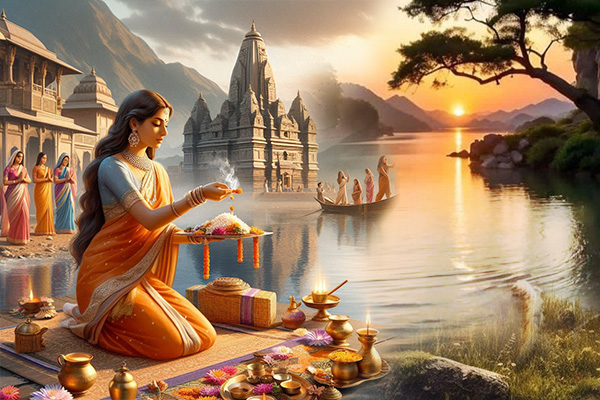
The word “chhath” means sixth in Nepali, Maithili, and Bhojpuri languages. This festival is celebrated on the 6th day of the month of Kartikeya of the Hindu Luni-Solar Bikram Sambat calendar and that’s why the name is Chhath Puja. This word is a Prakrit descent from the Sanskrit word “Sashthi”, and this festival is the one of longest and the most important festival of Hindus after the Navratri. It lasts for 4 days.
About Chhath Puja
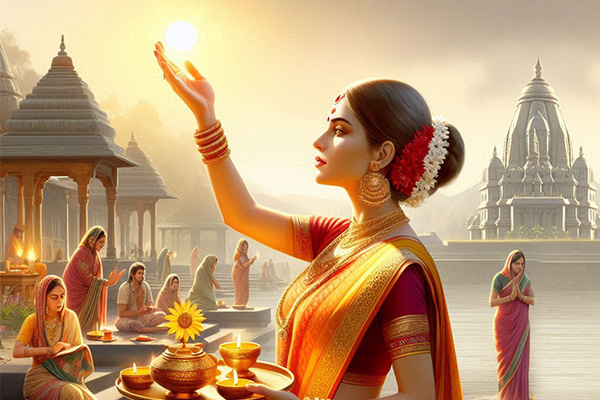
Chhath Puja is one of the most ancient festivals celebrated with great devotion and fervor by the Hindus residing in the Northern part of the country. The natives of Southern Nepal and the natives residing in Northern Part of India like the Bihar, Jharkhand, West Bengal and Uttar Pradesh. The natives of the above-mentioned regions worship the Sun God on the day of Chhath. Prayers are offered and hymns are sung in honor of Sun God. Furthermore, devotees offer thanks to the Sun Lord for the healthy crops, for life on Earth and for their wishes to be fulfilled.
Since ancient times, the rituals of performing the Chhath Puja have be practiced without any alterations or modification. Days before the Puja, all the people, especially women start preparing for the puja.
Chhath Puja 2026: Date, Muhurat, Tithi & Timing
Chhath Puja Day 1 — Nahay Khay
Date:
13th November 2026 (Friday / शुक्रवार)
Tithi:
Chaturthi
Sunrise:
06:45 AM
Sunset:
06:01 PM
Panchang:
For Nahay Khay Day
Chhath Puja Day 2 — Lohanda & Kharna
Date:
14th November 2026 (Saturday / शनिवार)
Tithi:
Panchami
Sunrise:
06:45 AM
Sunset:
06:00 PM
Panchang:
For Lohanda and Kharna Day
Chhath Puja Day 3 — Chhath Puja (Sandhya Arghya)
Date:
15th November 2026 (Sunday / रविवार)
Tithi:
Shashthi
Sunrise:
06:46 AM
Sunset:
06:00 PM
Panchang:
For Chhath Puja Day
Chhath Puja Day 4 — Usha Arghya & Parana
Date:
16th November 2026 (Monday / सोमवार)
Tithi:
Saptami
Sunrise:
06:46 AM
Sunset:
06:00 PM
Panchang:
For Usha Arghya Day
Note: Arghya offerings are performed at local sunset (Sandhya Arghya on Day 3) and at local sunrise (Usha Arghya on Day 4). City-wise sunrise/sunset may vary slightly.
Chhath Puja Story (Katha) | History of Chhath Puja
---1st-para---Goddess-Sita-performing-chhath-puja.jpg)
The Brahma Vaivarta Purana mentions that the Chhathi Maiya is worshipped on the Chhath festival. According to our rich history, the Sitacharan temple situated in Munger in the middle of Ganges is known for Sita Manpatthar. This is the most famous place where devotees gather to perform the puja of Chhath. According to the legend, it was at this very place in Munger where Mata Sita performed Chhath rituals. It is said that after She (Sita Mata) performed the Chhath puja, Chhathi Maiya blessed Her with two healthy sons namely Luv and Kush. After this episode, the tradition of performing Chhath Puja or the Chhath Mahaparv came into existence. This is the reason in Munger and Begusarai, the festivities of Chhat are performed with great fervor and devotion on a large scale.
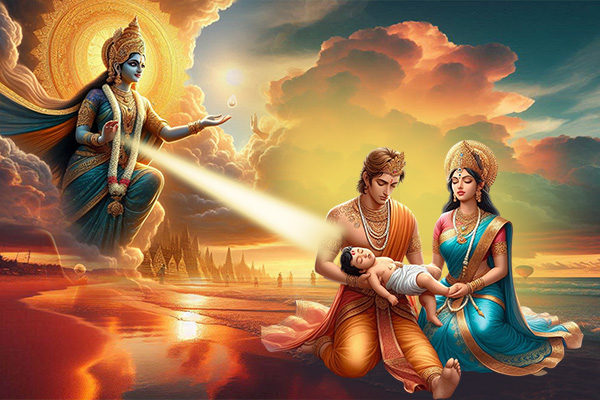
According to another legend, the First Manu Swayambhu had a son named ‘Priyavrat’. Though Priyavrat had all the riches and was a king, he did not have any children. This made him sad. Priyavrat consulted Maharishi Kashyap about this. After listening to King Priyavrat, Maharishi Kashyap told him to perform a Yajna. The rituals of the entire Yajna and puja were a little difficult, but the King and His wife performed the Yajna as guided by the Rishi. A few months passed and soon Queen Malini, wife of King Priyavrat gave birth to a son, but their happiness was short lived as the child was stillborn. The King and the Queen and their family members grieved. The King and his wife Malini were shattered but after some time they heard a voice in the sky and when they searched for it, they saw Mata Shashthi in the clouds. Both the King and the Queen bowed down to Her and with a sad heart offered prayers to Her. Goddess Shashthi blessed them and said, “I am Mata Chhathi, the sixth form of Goddess Parvati, I protect all the children and bless the one’s having difficulty in conceiving with a healthy offspring.”
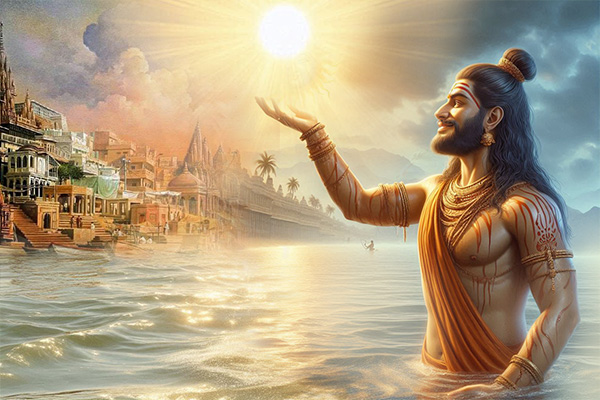
After saying this, Chatthi Maiya blessed the dead child with Her hands and the lifeless child was revived. Looking at the child breathing, both the King and His wife were overjoyed, and tears rolled down their cheeks. They offered thanks and prayers to Mata Chhathi and from that day onwards, the Chhath puja came to be celebrated with great devotion and vigor worldwide.
There is another enticing tale. The epic story of King Jarasandh and his miraculous treatment from leprosy via the practice of Chhath Puja is not just legendary, but it also has a fascinating scientific link. The rivers of Bihar, where Chhath Puja is extensively observed, contain natural amounts of Sulphur and arsenic. These elements are recognized for their therapeutic characteristics and have long been used to treat skin disorders such as leprosy.
Sulphur, often known as brimstone, has antibacterial and antifungal characteristics that may help cure a variety of skin conditions. Arsenic, in limited levels, has also been used in traditional medicine to treat chronic disorders such as leprosy. When devotees, such as King Jarasandh, conducted rituals standing in these rivers, they were most likely exposed to these natural ingredients, which aided in the treatment of skin problems.
Jarasandh's recovery from leprosy, attributed to his devotion to the Sun God and the healing properties of the river waters, prompted him to promote the widespread practice of Chhath Puja across his kingdom. This practice has been passed down through generations, combining spiritual dedication with a connection to nature's therapeutic abilities.
What to do on Chhath Puja?
To honor Surya, devotees fast, stay clean, and take holy dives in rivers. Preparing prasad, presenting arghya (water and prayers) to the sun, and evening and morning riverside worship are rituals. The event is supposed to bring families wealth, well-being, and peace.
How to Celebrate Chhath Puja? Chhath Puja Vrat Vidhi & Rituals
As mentioned above the festivities of Chhath Puja are celebrated with zeal and devotion by the women in the Northern part of India and Southern part of Nepal. In recent times many men too enthusiastically participate and perform the rituals of Chhath. The four-day celebrations begin with
13th November 2026 (Day 1): Nahaay Khaay
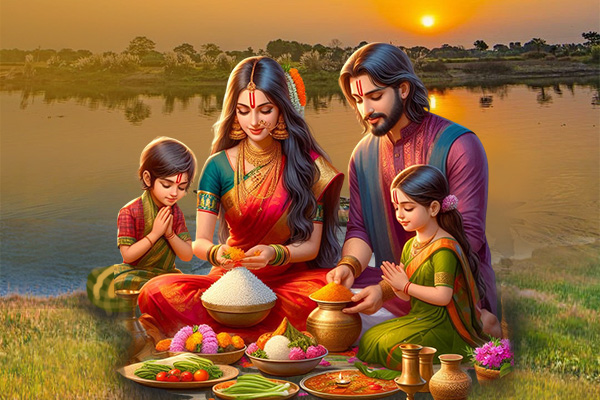
On this day, the ‘parvaitin’ (the main worshipper) takes a bath and wears fresh clothes. Once this is done, they offer prayers to Lord Surya for bestowing prosperity, well-being of the family, and to give a healthy and successful life to children. Generally, in the Chhath Puja the main worshippers or the Parvaitin are women. Though this puja is not specific to a particular gender but since ancient times, the women have been main worshippers of this festival. Once the puja is done, the Parvaitin cleans the entire house and the surrounding areas and also the pathway that leads to the Ghat. The devotees make sure that the paths to Ghat are thoroughly cleaned. The Parvaitin then cooks Satvik food which comprises of Kaduaa Bhaat (Bottle Gourd and Bengal gram lentils cooked with Arva Rice). This preparation is first offered to the deity in the afternoon as a Bhog and is then consumed by the Parvaitin. This food marks the last meal of the Parva (festival) and is eaten by the Parvaitin with an intention to ward off vengeance and other negative thoughts.
14th November 2026 (Day 2): Kharna/Lohanda
-Kharna-Lohanda.jpg)
The second day of Chhath is known as Kharna. Devotees and the Parvaitin observe Nirjala fasting which means, the devotees cannot even consume water till the Sun sets. In the evening, the devotees eat gur ke kheer (sweet delicacy made by cooking rice with milk and jaggery) with Roti. This Kheer is popularly known as Rasia.
15th November 2026 (Day 3): Sanjhka Aragh
-Sanjhka-Aragh.jpg)
The third day of Chhath Puja is the day when the Parvaitin and other family members are busy preparing prasad (offerings to God) at home. Prasad is usually offered in a bamboo basket which is filled with fruits, rice laddus and Thekua (sweet snack). On the eve of Sanjhka Aragh, the Parvaitin is accompanied to the river, pond or other large body of water by the family members and friends to make the Arghya (offerings to the Lord) of the prasad to the setting sun by standing in the water body. The celebrations of this day are worth witnessing as people gather in large numbers around the water bodies to witness the worshippers and the puja being performed. The onlookers even help the worshippers if needed to receive the worshipper's blessings. While offering prasad (Arghya), the devotees offer Gangajal water to the Sun Lord by entering the water body with the prasad and Kalash full of Gangajal. Once the worship is done, the worshippers return to their houses and perform the ‘kosi bharai’ ritual along with their family members, friends and neighboring households.
16th November 2026 (Day 3): Kosi Bharai (After Sanjh ka Argh)
--Kosi-Bharai-(After-Sanjh-ka-Argh).jpg)
The ritual of Kosi Bharai is performed by the married couple or an individual who observes the vrat(fasting) of Chhath. According to an age-old belief, if a wish or vow of an individual who has observed the fasting for Chhath is fulfilled then he/she must perform a ritual of filling the Kosi as a celebratory repayment. The ritual of Kosi Bharai is performed on the terrace or in the courtyard of the house. Five to seven sugarcanes are tied together, and a canopy (tambu/ mandap) is made. Under the canopy, the thekua (food offering made for chhath puja), fruits, fruit extracts and Keravas are placed. The canopy is then tied with a new red saree from the top. Once this is done a hollow elephant is prepared of clay(clay) and it is placed under the canopy in the centre. On top of it an earthen Pot is kept which is filled with Sathi chawal (a type of rice) kasar (sweet laddus) and dhan ka chivda(flattened wheat sweet and savoury snack). After this 12 to 24 oil or ghee diyas (ghee/oil lamps) are lit and seasonal fruits are offered. The same ritual is repeated the next morning between 3 am and 4 am, and afterward the devotees offer arghya or other offerings to the rising Sun.
17th November 2026 (Day 4): Bhor ka Aragh
-Bhorka-Aragh.jpg)
The last day of the Chhath Puja is called as the Bhorka Aragh. On this day, the devotees wake up before sunrise, freshen up and go to the riverbanks or any other water body that is near to their house and offer Arghya to the rising sun. While offering Arghya, the Parvaitin offers prayers to the Sun Lord and Chhatti Maiya asking the deities to protect the kids, create harmonious relationships with family, and to bless the family with peace and prosperity. Once, the Arghya and prayers are offered, the Parvitin sips water and consumes a morsel or two of the prasad in order to break the fast. This is known as Parana or Paran.
During the period of Chhath, in Mithila some women wear Dhoti made of pure cotton. This Dhoti is not stitched reflecting the ancient traditional Mithilanchal culture.
How to Do Chhath Puja at Home?
If you want to keep a Chhath Puja at your place, the first day is Nahay Khay, when you should clean yourself and your surroundings carefully. The second day is Kharna, when you should fast, breaking it with a small meal after sunset. On the third day, get everything ready for the evening Arghya, which entails giving milk and water to the sun as it sets. To mark the end of fasting, give Arghya to the rising sun the next morning.
If you follow the instructions provided in the puja ritual heading, you may observe these ancient rituals in the comfort of your own home, paying homage to the Sun God and the natural world in the process.
Why Chhath Puja Celebrated? Importance and Significance of Chhath Puja
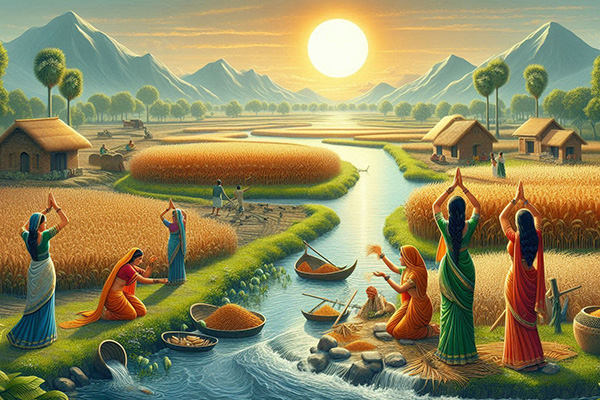
The Sun God Surya and his wife Usha, who are said to be the ones who keep life on Earth going, are worshipped and honored at Chhath Puja. To many, the Sun is a divine being who bestows health, wealth, and vigor. A celebration of life's many gifts and a wish for the health, happiness, and longevity of loved ones are at the heart of the celebration.
Worship of the Sun God: The Sun is considered as a potent god who controls well-being and wealth. Devotees seek the blessings of the Sun God for themselves and their family by giving prayers and conducting rituals during dawn and dusk.
Mythological Significance: In the Mahabharata, the son of Surya named Karna is said to have been the first to conduct Chhath Puja, according to Hindu mythology. Legend has it that Draupadi and the Pandavas used Chhath Puja to win back their kingdom that they had lost. Chhathi Maiya, also known as Mother Shashti, is worshipped throughout the festival for her role as a guardian of children.
Fertility and Agricultural Prosperity: Since Chhath Puja is observed after the harvest, it has strong ties to farming. It is customary to pray for continued agricultural success and to thank the Sun God for the energy that crops need to thrive.
Environmental and Health Benefits: Fasting, cleansing in rivers, and exposing oneself to sunshine are all part of the Chhath Puja traditions, which are said to provide health advantages include cleansing the body and improving mental and physical well-being.
Overall, Chhath Puja is celebrated to express reverence for the natural forces that sustain life and to seek blessings for health, prosperity, and longevity. It is a festival of deep spiritual significance, marked by devotion, discipline, and respect for nature.
Chhath Puja Associated Products & Services
Rudra Centre is a one stop solution to all spiritual and religious tools. All the sacred items that are either required to venerate or to enhance spiritual practices like meditation, religious Puja or Sadhna are given below:
12 Mukhi Rudraksha:
The 12 Mukhi Rudraksha is associated with brilliance, intelligence, radiance and power. It is ruled by Surya Dev and the planet Sun. Thus, the wearer of the 12 Mukhi Rudraksha is blessed with self-assurance, leadership qualities, strength, and vitality. As Chhath Puja is all about worshipping Sun God, wear this Rudraksha to enhance your Puja.
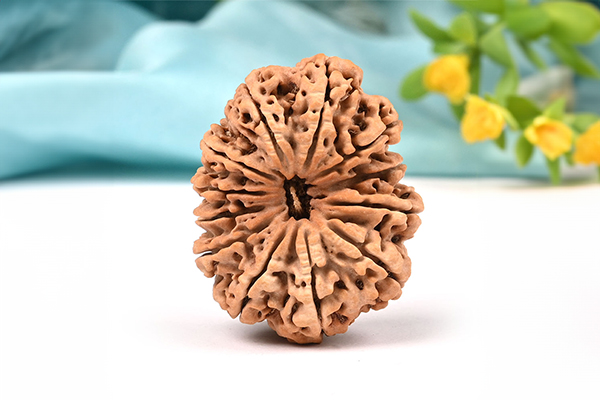
Surya Puja Japa and Yagya:
Surya Grah puja mantra Japa and yajna is performed to enhance the benefit of planet Sun and remove its malefic effects. Worship of the Sun is deeply rooted in Hindu culture and rituals, with dedicated prayers and hymns that express reverence and gratitude for the Sun's blessings. The Sun is also associated with knowledge, wisdom, and enlightenment. By offering prayers and meditating on the Sun, devotees attain spiritual and physical well-being, as well as gain clarity of mind and a deeper understanding of life.
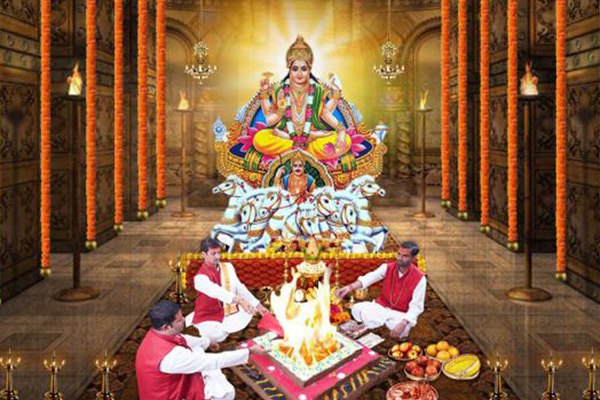
Parvati Chalisa Path: Maa Parvati is an embodiment of a caring Mother, she is the goddess of love, compassion, peace, power, strength, energy and beauty. She is the Supreme feminine energy who represents Mahadevi. Worship Maa Parvati in her Chhathi Maiya form to receive blessings and abundance.
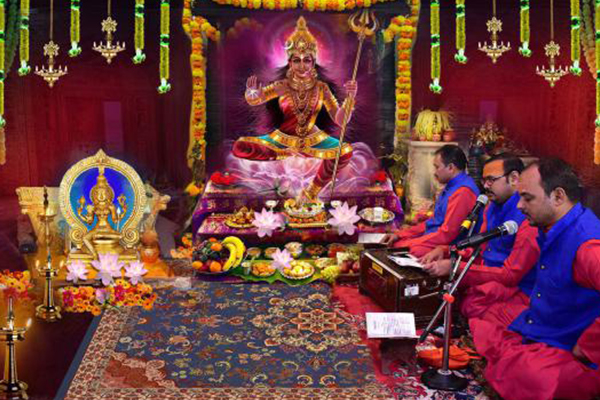

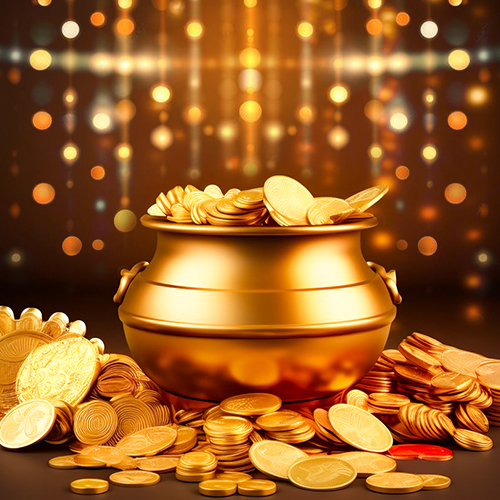
-in-Astrology.jpg)
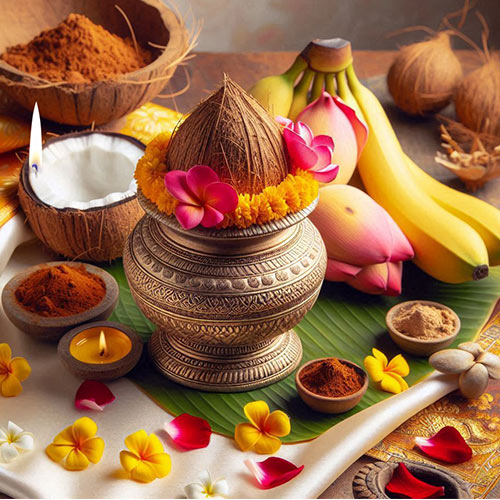
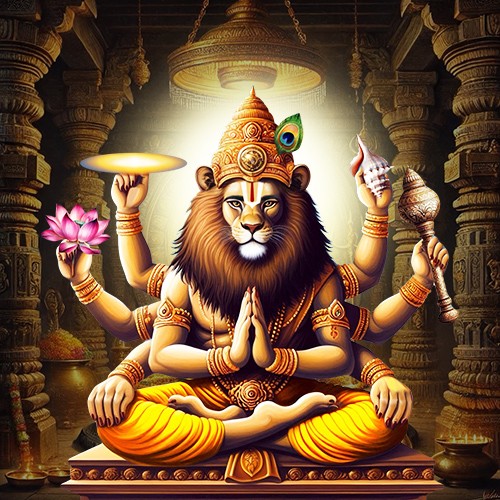
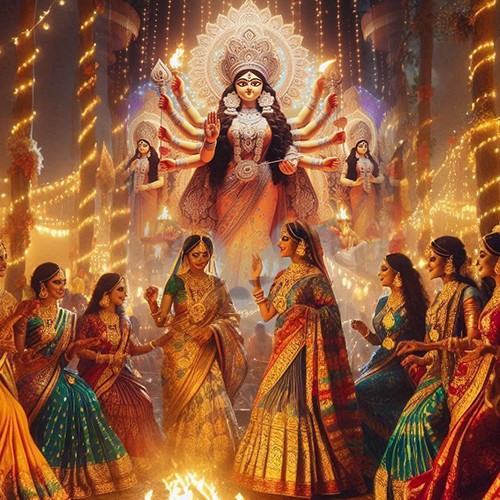
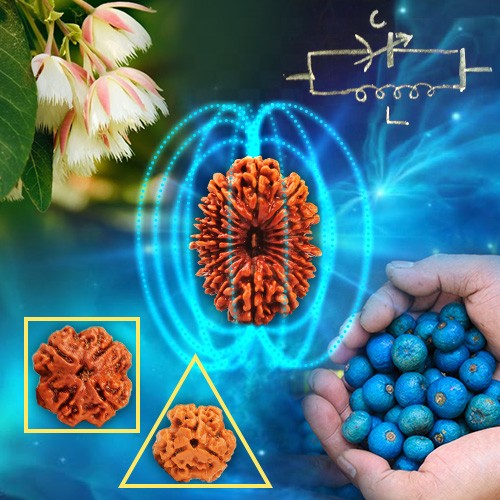

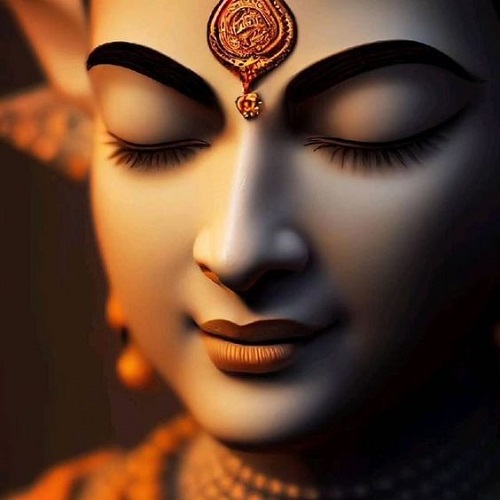
.jpg)
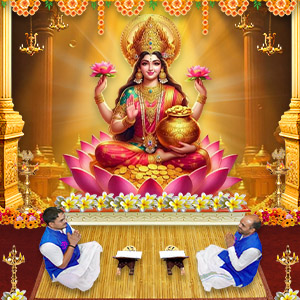
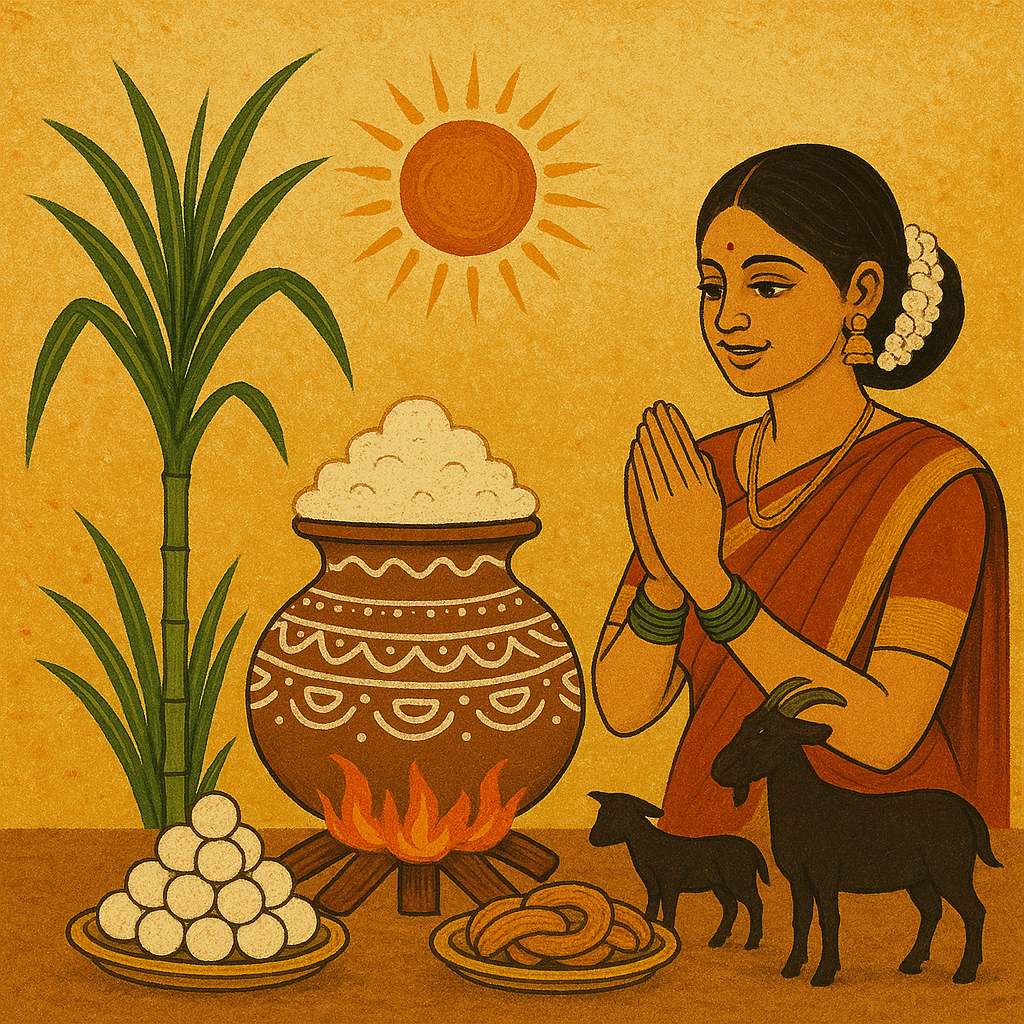
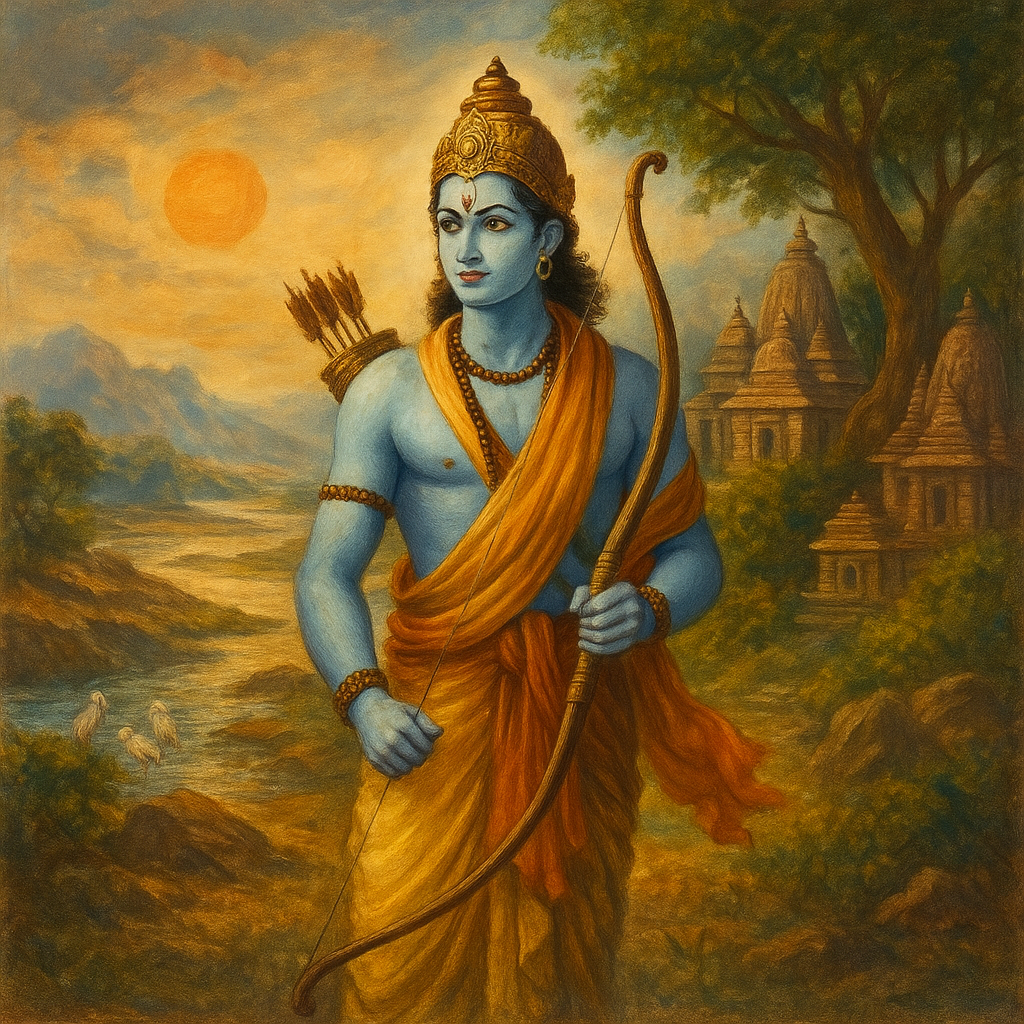
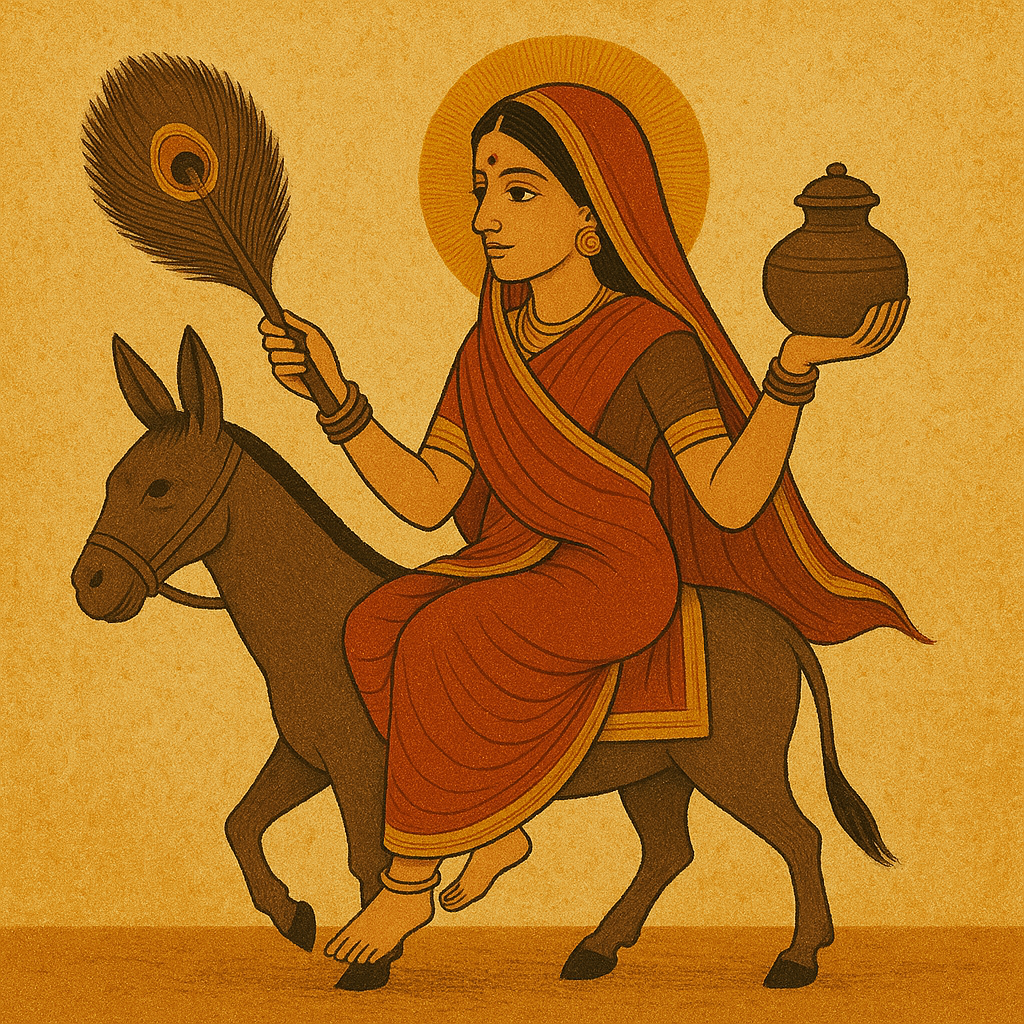
Comments 0
Leave your thought here